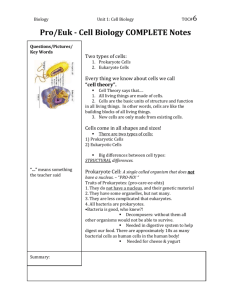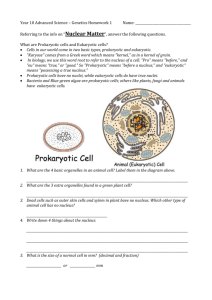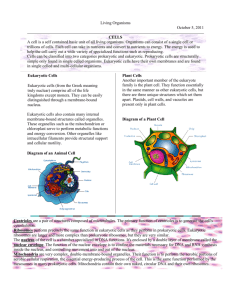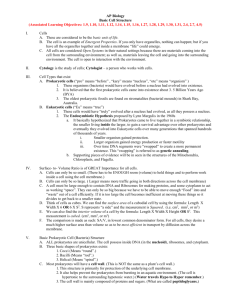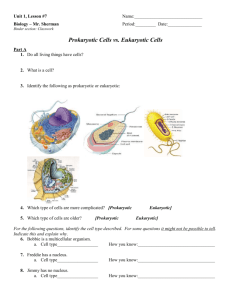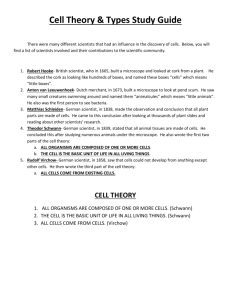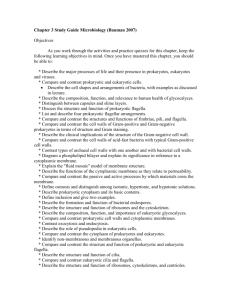Prokaryote cells
advertisement
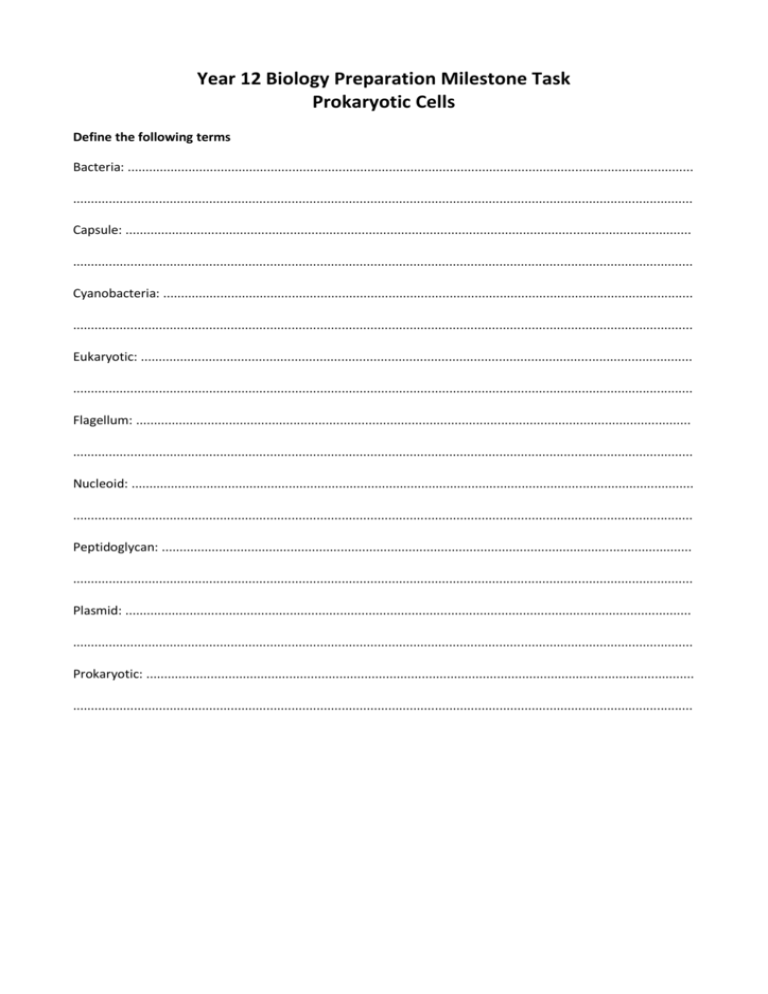
Year 12 Biology Preparation Milestone Task Prokaryotic Cells Define the following terms Bacteria: .............................................................................................................................................................. ............................................................................................................................................................................. Capsule: .............................................................................................................................................................. ............................................................................................................................................................................. Cyanobacteria: .................................................................................................................................................... ............................................................................................................................................................................. Eukaryotic: .......................................................................................................................................................... ............................................................................................................................................................................. Flagellum: ........................................................................................................................................................... ............................................................................................................................................................................. Nucleoid: ............................................................................................................................................................. ............................................................................................................................................................................. Peptidoglycan: .................................................................................................................................................... ............................................................................................................................................................................. Plasmid: .............................................................................................................................................................. ............................................................................................................................................................................. Prokaryotic: ......................................................................................................................................................... ............................................................................................................................................................................. Complete the sentences using the words in bold a nucleus flagella bacteria cell wall chloroplast cilia circular eukaryotic golgi mitochondria nuclear envelope nucleus organelles respiration ribosomes SER smaller two evolved RER It was once common practice to classify all living organisms as either animals or plants. With improved knowledge of living things it has become apparent that there are ________ fundamentally different types of cell. The most obvious difference between the two types is that one possesses a _____________ and the other does not. The cells of animals, plants, fungi and protists contain many membrane-bound ______________, one of which is the nucleus that is surrounded by the ______________ ________________.These are referred to as ______________ cells (meaning ‘with a true nucleus’). Prokaryotes (meaning ‘before the nucleus’), which are mostly _______________, are very different to eukaryotes because they lack membrane-bound organelles. Prokaryotes, therefore, do not contain _______________, _______________, _______________, _______________, ________, or ________. Instead they have: • A _______________ chromosome that floats freely in the cytoplasm • _____________, that are smaller circular pieces of DNA and can be replicated and shared between bacterial cells • Folded regions of the cell membrane, that are responsible for _______________ (and sometimes photosynthesis) • _______________, that are smaller than those in a eukaryote • A _________ _________, that is made out of peptidoglycan (a mixture of polypeptides and carbohydrates) rather than cellulose • They may also have ______________ (for motility) or ___________ (for sensing their environment) Prokaryotic cells are about 100 to 10000 times ______________ than eukaryotic cells. Biologists believe eukaryotes ______________ from prokaryotes, and that the organelles were originally prokaryotic cells that formed a symbiotic relationship with the eukaryotic cell. Answer the questions 1. The diagram below shows Staphylococcus, which is a prokaryotic cell. Label parts A to D. [4] A. B. C. D. 2. Use table 1 to compare plant (eukaryote), animal (eukaryote) and prokaryotic cells. For each cell type indicate whether the feature is present or absent using a tick or cross. [16] Feature Chloroplasts Large permanent vacuole Cellulose cell wall Peptidoglycan cell wall Linear chromosome Circular chromosome Plasmids Endoplastic Reticulum Golgi body DNA free in the cytoplasm DNA in nucleus ATP is produced in the mitochondria Flagella possible Relative ribosome sizes Cell membrane Plant cells Animal cells Prokaryote cells 3. Prokaryotic cells have one membrane, where is it? [1] ............................................................................................................................................................................. 4. Give 2 ways in which prokaryotes are useful to humans. [2] ............................................................................................................................................................................. ............................................................................................................................................................................. 5. Mitochondria and chloroplasts contain small loops of DNA similar to the plasmids found in prokaryotic cells. These organelles also contain ribosomes that are the same size as prokaryotic ribosomes. Can you suggest an explanation for these features? [2] ............................................................................................................................................................................. ............................................................................................................................................................................. 6. Give one way in which a eukaryotic plant cell is similar to a prokaryote.[1] ............................................................................................................................................................................. 7. Name the features 1-11 on the diagram of the bacterium E.coli shown in the diagram below. [11] 1 2 3 4 5 6 7 8 9 10 11 Answer the exam questions Q1. (i) (a) The diagram shows a bacterial cell. Name the parts labelled D and E. [2] D .......................................................................................................................................................................... E .......................................................................................................................................................................... (ii) Give one function of the cell wall. [1] ............................................................................................................................................................................. ............................................................................................................................................................................. (b) Name two structures present in eukaryotic cells that are not present in the cells of prokaryotes. [2] 1 .......................................................................................................................................................................... 2 .......................................................................................................................................................................... Q2. (a) The structure of a cholera bacterium is different from the structure of an epithelial cell from the small intestine. Describe how the structure of a cholera bacterium is different. [5] ............................................................................................................................................................................. ............................................................................................................................................................................. ............................................................................................................................................................................. ............................................................................................................................................................................. ............................................................................................................................................................................. ............................................................................................................................................................................. ............................................................................................................................................................................. (Total 5 marks)
